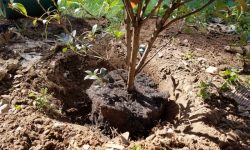Dogwood trees are beloved for their stunning spring blossoms, vibrant fall foliage, and graceful form. Their moderate size and ornamental appeal make them ideal for home gardens and landscaped yards. Many gardeners are curious about how fast dogwood trees grow and what factors influence their development. Understanding growth patterns helps plan garden layouts and ensures the tree thrives for years to come.
Growth rates vary depending on climate, soil quality, sunlight, and care practices. While dogwoods are generally slow to moderate growers, providing the right conditions can encourage stronger roots, healthier branches, and more abundant blooms. This guide offers expert tips for promoting healthy growth, helping your dogwood reach its full potential and bring lasting beauty to your garden.
Understanding the Growth Rate of Dogwood Trees

Dogwood trees are generally considered slow to moderate growers. On average, they gain about 1 to 2 feet of height per year under optimal conditions. This slower growth rate allows the tree to develop strong structural roots and a stable trunk, which are essential for long-term health. While the growth may seem gradual, the benefits include durability, fewer maintenance issues, and consistent flowering each season. Understanding this natural pace helps gardeners plan spacing and landscape design effectively.
Several factors influence how fast dogwood trees grow. Soil quality, moisture levels, sunlight, and temperature all play significant roles. Well-drained, slightly acidic soil promotes healthy root development, while consistent watering prevents stress that can stunt growth. Climate also affects growth, as trees in warmer zones often establish quicker than those in cooler regions. By providing ideal environmental conditions, gardeners can maximize growth potential without forcing the tree, maintaining its natural beauty and stability.
Care practices directly impact growth as well. Proper mulching, timely pruning, and fertilization support healthy branch and foliage development. Avoiding common mistakes, such as overwatering or planting too deep, ensures the tree focuses energy on vertical and lateral growth. Observing the tree regularly allows adjustments in care to promote steady progress. With patience and attention, gardeners can enjoy a robust dogwood that combines slow elegance with reliable seasonal blooms.
Factors Affecting Dogwood Growth
Soil Quality and Composition
Soil quality is one of the most influential factors in determining how fast dogwood trees grow. Dogwoods prefer slightly acidic, well-drained soil with a pH range of 5.5 to 6.5. Soil that is compacted or heavy in clay restricts root expansion, slows nutrient uptake, and ultimately reduces growth. Poor soil conditions make trees more vulnerable to stress, drought, and disease. Gardeners often underestimate the importance of soil preparation, but establishing a rich, loose soil environment from the start supports long-term tree health and vitality.
Amending the soil with compost, leaf mold, or pine bark improves drainage, aeration, and nutrient availability. Regular soil testing helps track nutrient levels and pH balance, allowing for timely adjustments with fertilizers or soil amendments. Healthy soil encourages roots to grow deeply and spread evenly, supporting both vertical growth and canopy development. Well-prepared soil also enhances the tree’s resilience against pests and fungal infections. Investing in proper soil management ensures dogwoods grow steadily, produce vibrant leaves, and develop strong flowers, contributing to a beautiful, long-lasting landscape.
Sunlight Exposure
Sunlight is critical to dogwood growth and overall vitality. These trees thrive in partial shade, benefiting from morning sun and protection from intense afternoon heat. Insufficient sunlight can slow growth, reduce leaf size, and diminish flowering, while excessive sun exposure can scorch leaves and cause stress, negatively affecting long-term health. Evaluating light conditions before planting ensures that the tree receives optimal energy for photosynthesis and development.
Strategic placement is crucial, especially in hotter climates. Providing filtered sunlight or partial shade shields dogwoods from extreme heat and allows steady growth of leaves and branches. Observing seasonal sunlight patterns helps gardeners choose the best site. Adequate light exposure stimulates vigorous photosynthesis, leading to stronger stems, healthier foliage, and more abundant blooms. Maintaining a balance between sun and shade maximizes growth potential and ensures dogwoods remain attractive, robust, and capable of withstanding environmental stress throughout the year.
Watering and Moisture Levels
Water management is vital for dogwood growth. Both overwatering and underwatering can hinder development. Inadequate moisture stresses roots, limiting nutrient uptake and slowing growth, while saturated soil deprives roots of oxygen and increases the risk of fungal infections. Achieving proper balance in soil moisture is essential for steady tree growth and overall vitality.
Young dogwoods require frequent watering until their roots establish, while mature trees thrive with deep, infrequent irrigation to encourage strong root systems. Mulching around the base retains soil moisture, reduces evaporation, and stabilizes soil temperature. Monitoring rainfall, soil drainage, and local conditions allows gardeners to adjust watering practices effectively. Consistent and appropriate moisture supports healthy leaves, robust branches, and abundant flowering, ensuring dogwoods grow steadily and reach their full potential in both height and canopy size over time. Proper hydration is crucial for long-term tree health and beauty.
Climate and Temperature
Climate significantly affects how fast dogwood trees grow. Trees in warmer, temperate regions generally establish more quickly than those in cooler northern zones. Temperature fluctuations, frost events, and seasonal changes directly influence bud development, leaf growth, and flowering patterns. Adapting care to local climate conditions is crucial for consistent growth and long-term tree success.
Gardeners should consider local weather patterns when selecting planting times and dogwood varieties. In warm regions, fall planting allows roots to establish before summer heat, while spring planting may be more suitable in cooler climates. Protecting trees from extreme temperatures, including late frosts or prolonged heatwaves, ensures steady development. By understanding the climate and seasonal conditions, gardeners can optimize growth potential, promote healthy foliage, and enjoy vibrant blooms. Climate-conscious care helps dogwoods flourish and maintain structural strength, ensuring a beautiful and enduring presence in the landscape.
Tips to Encourage Faster Growth in Dogwood Trees
Select the Right Dogwood Variety
Choosing the appropriate dogwood variety is critical for encouraging healthy and fast growth. Different varieties have varying growth rates and climate tolerances. For instance, Cornus florida thrives in temperate climates and offers consistent spring blooms, while Cornus kousa is better suited for warmer regions with longer growing seasons. Selecting a variety compatible with local conditions reduces stress, allows roots to establish efficiently, and promotes faster vertical and lateral growth.
Nursery selection also impacts long-term growth. Healthy, well-rooted specimens with strong stems and disease-free foliage establish more quickly than weak or stressed trees. Avoid varieties prone to local pests or fungal infections to prevent growth setbacks. By investing time in choosing the right variety, gardeners provide a solid foundation for sustained development, vibrant leaves, and reliable flowering. Proper variety selection ensures that dogwoods not only grow steadily but also reach full size with strong structural integrity over the years.
Provide Adequate Sunlight and Protection
Sunlight is a key driver of photosynthesis, influencing growth rate and overall vitality. Dogwoods grow best with morning sunlight and protection from hot afternoon sun. Insufficient light slows leaf expansion and branch development, while excessive sunlight can scorch foliage and stress the tree, limiting root and flower development. Understanding sunlight patterns in your garden helps position the tree for optimal growth.
Protection from harsh winds and extreme weather conditions is also important. Wind can break branches, increase water loss, and reduce leaf area, slowing growth. Strategic placement near structures or companion plants provides natural windbreaks. Maintaining a balance between adequate sunlight and protection ensures dogwoods develop strong roots, healthy stems, and dense foliage. Healthy trees can grow faster and produce more abundant, long-lasting seasonal blooms while remaining resilient against environmental stressors.
Proper Watering and Mulching
Consistent watering is essential for dogwood health and growth. Newly planted trees need frequent irrigation to establish roots, while mature trees benefit from deep, less frequent watering to encourage strong, deep root systems. Improper watering, either too much or too little, can stunt growth or lead to root diseases. Monitoring soil moisture and adjusting irrigation based on weather conditions supports steady growth and healthy foliage.
Mulching enhances soil moisture retention, reduces temperature fluctuations, and prevents weed competition. Organic mulch, such as wood chips or shredded bark, slowly enriches the soil as it decomposes, improving nutrient availability and soil structure. Combined with proper watering, mulching ensures a stable environment for root development and canopy expansion. These practices promote lush foliage, strong stems, and abundant flowering, helping dogwoods achieve their full growth potential efficiently.
Regular Fertilization and Nutrient Management
Proper fertilization encourages faster growth and supports overall tree health. A balanced, slow-release fertilizer applied in early spring provides essential nutrients for root establishment, leaf development, and branch expansion. Excess nitrogen should be avoided, as it encourages leafy growth at the expense of flowers, potentially affecting long-term tree health. Soil testing is recommended to determine deficiencies and guide fertilizer application.
Supplemental feeding during the growing season maintains vigor, particularly in soils lacking essential nutrients. Combined with appropriate watering and mulching, nutrient management ensures energy is directed toward structural growth and flowering. Healthy trees develop denser canopies, stronger branches, and more resilient root systems. By managing nutrients carefully, gardeners can significantly accelerate growth, achieve vibrant foliage, and enjoy long-lasting blooms, ensuring their dogwoods reach both aesthetic and structural potential efficiently.
Common Mistakes That Slow Dogwood Growth
Planting in the Wrong Location
Planting dogwoods in an unsuitable location is a common reason for slow growth and poor flowering. Dogwoods thrive in partial shade, ideally with morning sunlight and protection from harsh afternoon sun. Planting in full shade reduces photosynthesis, stunting leaf and branch development, while full sun exposure in hot climates can scorch foliage and stress roots. Both extremes weaken the tree and limit flower production.
Soil drainage and protection from environmental stress are equally critical. Waterlogged soil can suffocate roots and promote fungal infections, whereas compacted or poorly drained soil restricts root expansion. Additionally, sites exposed to strong winds or extreme temperatures may damage branches and inhibit canopy development. Selecting a location with filtered sunlight, well-drained soil, and wind protection ensures steady root establishment, faster growth, and stronger tree structure. Thoughtful site selection prevents growth setbacks and supports long-term tree health, vibrant foliage, and abundant blooms.
Overwatering or Underwatering
Water management errors can severely impact dogwood growth. Overwatering saturates the soil, depriving roots of oxygen and increasing susceptibility to root rot and fungal diseases. Conversely, underwatering stresses the roots, limiting nutrient absorption and slowing overall growth. Young trees require frequent watering to establish roots, while mature trees benefit from deep, infrequent irrigation that encourages strong root systems and canopy development.
Mulching can aid in moisture retention, regulate soil temperature, and reduce evaporation, but it cannot replace proper watering practices. Gardeners should monitor soil moisture and adjust irrigation according to rainfall, season, and temperature fluctuations. Maintaining balanced moisture ensures vigorous root expansion, healthy leaves, and steady growth of branches. Proper water management allows dogwoods to thrive naturally, supporting structural integrity, vibrant foliage, and reliable seasonal blooms without the setbacks caused by inconsistent or improper watering.
Ignoring Soil Quality
Soil preparation and maintenance are crucial for dogwood health and growth. Dogwoods prefer slightly acidic, well-drained soils enriched with organic matter. Planting in clay-heavy, compacted, or infertile soil restricts root development, reduces nutrient absorption, and slows both canopy expansion and flower production. Neglecting soil quality is a frequent cause of stunted growth and poor long-term tree performance.
Amending the soil with compost, leaf mold, or organic fertilizers improves drainage, aeration, and nutrient availability. Regular soil testing helps gardeners monitor pH and nutrient levels, guiding timely adjustments for optimum growth. Healthy, fertile soil encourages deep root systems, robust foliage, and a strong framework for flowering. Investing in proper soil preparation ensures that dogwoods establish quickly, grow vigorously, and maintain consistent flowering and foliage throughout their lifespan, avoiding the growth delays caused by poor soil conditions.
Neglecting Fertilization and Pruning
Improper fertilization and incorrect pruning can hinder dogwood growth significantly. Overuse of nitrogen-heavy fertilizers encourages leafy growth at the expense of flowers, while nutrient deficiencies slow root expansion and branch development. Similarly, pruning at the wrong time, such as during flowering or late summer, can remove developing buds and reduce energy allocation for future growth.
Applying balanced fertilizers in early spring and supplemental feeding during the growing season promotes root, branch, and bud development. Pruning during late winter or early spring removes dead or crowded branches and encourages strong structural growth without sacrificing blooms. Regular attention to both fertilization and pruning ensures dogwoods develop dense canopies, robust roots, and abundant seasonal flowers. Avoiding these mistakes supports steady, long-term growth, tree resilience, and vibrant floral displays year after year.
Long-Term Care Tips for Healthy and Fast-Growing Dogwoods
Consistent Watering and Mulching
Maintaining consistent soil moisture is essential for long-term dogwood health. Young trees require frequent watering to establish roots, while mature trees benefit from deep, infrequent watering that encourages strong root growth. Overwatering or prolonged dryness can stress the tree, reducing both growth rate and flowering potential. Regular monitoring of soil moisture helps gardeners adjust irrigation based on rainfall and temperature fluctuations, ensuring optimal conditions for root development.
Mulching enhances the benefits of proper watering. A 2–3 inch layer of organic mulch around the base helps retain soil moisture, regulate temperature, and prevent weed competition. As mulch decomposes, it enriches the soil with organic matter, improving fertility and structure. Consistent watering combined with mulching provides a stable environment, supporting healthy foliage, robust branches, and abundant seasonal blooms. By committing to these long-term practices, gardeners promote steady growth and strong, resilient dogwoods capable of thriving for decades.
Seasonal Fertilization
Fertilization is a cornerstone of long-term dogwood care, directly influencing growth rate, flowering, and overall tree health. Applying a balanced, slow-release fertilizer in early spring provides essential nutrients such as phosphorus, potassium, and trace minerals. These nutrients support root establishment, leaf development, and flower bud formation. Care must be taken to avoid excessive nitrogen, which promotes leafy growth at the expense of blooms, potentially reducing flower quality and overall tree vigor. Proper timing and correct nutrient balance ensure that dogwoods develop strong stems, dense foliage, and healthy root systems capable of sustaining vigorous seasonal growth.
Supplemental feeding during the growing season helps maintain steady vigor, especially in nutrient-depleted soils. Regular soil testing guides gardeners to correct deficiencies, adjusting fertilization practices based on pH and nutrient levels. Combining fertilization with adequate watering and mulching maximizes nutrient uptake and soil moisture retention. Over time, this holistic approach ensures dogwoods grow at an optimal rate, develop a robust canopy, and produce long-lasting, vibrant blooms. Proper seasonal fertilization enhances structural integrity, resilience against pests and diseases, and overall aesthetic appeal, allowing dogwoods to thrive in every landscape setting.
Timely Pruning and Structural Care
Pruning is essential for maintaining dogwood health, shape, and long-term growth. Removing dead, diseased, or crowded branches in late winter or early spring improves air circulation and light penetration, reducing the risk of fungal infections and pest infestations. Timely pruning directs energy to healthy buds, promoting vigorous shoot and flower development. Pruning during bloom or late summer can remove developing flowers, slow canopy growth, and reduce seasonal flowering, making proper timing critical for maximizing both structural integrity and aesthetic appeal.
Structural pruning also strengthens the tree framework and encourages balanced canopy expansion. Removing weak or overextended branches prevents breakage during storms or heavy snow, while shaping the tree allows for even growth and long-term resilience. Combined with consistent watering, seasonal fertilization, and mulching, proper pruning enhances dogwood vigor, ensuring steady growth and abundant, vibrant blooms year after year. Regular attention to structural care supports a strong, healthy tree capable of thriving in diverse climates and garden settings while maintaining its natural beauty and ornamental value.
Monitoring for Pests and Diseases
Long-term dogwood health relies heavily on proactive monitoring for pests and diseases. Common threats include aphids, scale insects, borers, and fungal infections such as anthracnose or powdery mildew. Left unchecked, these pests and diseases can weaken branches, stunt growth, and reduce flowering. Regular inspections, especially during spring and summer, help gardeners detect early signs of infestation or infection, allowing timely interventions before serious damage occurs. Early action preserves the tree’s energy for canopy development, root expansion, and seasonal blooms rather than recovery from stress.
Integrated pest and disease management combines cultural, mechanical, and chemical approaches to protect dogwoods. Encouraging natural predators, using horticultural oils, or applying targeted fungicides can control pests while minimizing harm to beneficial insects. Maintaining proper spacing, pruning for airflow, and ensuring well-drained soil further reduce susceptibility to disease. Vigilant monitoring and preventive care support steady growth, strong structural integrity, and abundant flowering. Healthy trees are more resilient to environmental stress, consistently produce vibrant blooms, and thrive for decades when pests and diseases are managed effectively.
Soil and Nutrient Management for Optimal Growth
Soil quality is the foundation for strong dogwood growth. Well-drained, slightly acidic soil promotes healthy root development and supports steady canopy expansion. Poorly drained or compacted soil can stunt growth, reduce flowering, and increase susceptibility to pests and diseases. Amending soil with organic matter such as compost or leaf mold improves texture, fertility, and moisture retention. This provides a stable environment where dogwoods can establish robust roots and develop a dense, healthy canopy over time.
Nutrient management is equally important. Balanced fertilization in early spring supports root growth, encourages vigorous shoots, and enhances flower bud formation. Avoid over-fertilizing with nitrogen-heavy products, which can lead to excessive leaf growth at the expense of blooms. Periodic soil testing helps identify deficiencies in phosphorus, potassium, or micronutrients and allows gardeners to adjust fertilization accordingly. Proper nutrient management ensures the tree remains vigorous, resilient, and capable of rapid, sustained growth.
Incorporating long-term soil practices, such as mulching and adding organic matter annually, maintains soil fertility and moisture balance. Mulching reduces temperature fluctuations, suppresses weeds, and slowly enriches the soil as it decomposes. Combined with careful watering and disease prevention, these practices create an optimal environment that accelerates growth, supports structural health, and ensures abundant, long-lasting blooms year after year. Healthy soil ultimately allows dogwoods to reach their full aesthetic and ecological potential.
Environmental Factors Affecting Growth
Dogwoods are sensitive to environmental conditions that directly influence growth rates. Temperature plays a crucial role; trees in moderate climates with warm springs often grow faster than those in cooler zones. Consistent sunlight encourages photosynthesis, fueling shoot elongation and flower development. However, too much direct afternoon sun can scorch leaves, while full shade may slow growth. Proper site selection balances light exposure to optimize both foliage health and bloom production.
Water availability also impacts growth. Drought stress or irregular watering weakens roots, limits shoot development, and reduces flowering. Well-drained soil combined with regular irrigation promotes steady growth and healthy foliage. Mulching helps retain moisture and regulate soil temperature, mitigating the effects of hot or dry conditions. Understanding the local climate allows gardeners to adjust care routines, protecting trees from environmental extremes that could hinder growth or flowering.
Other environmental factors, such as wind exposure and urban pollution, can affect structural development and long-term health. Strategic placement in partially sheltered locations prevents branch breakage and minimizes stress. Gardeners can enhance resilience by monitoring microclimates and providing supportive measures like windbreaks or shade structures. By actively managing environmental factors, dogwoods grow faster, maintain health, and consistently produce vibrant blooms.
Companion Planting and Landscaping Benefits
Companion planting can significantly influence dogwood growth and overall garden health. Selecting plants that share similar soil and light requirements creates a supportive microenvironment. Groundcovers, shade-tolerant perennials, and nitrogen-fixing plants improve soil fertility, reduce erosion, and maintain moisture levels. These companion plants also attract pollinators and beneficial insects, enhancing ecological balance and indirectly supporting healthy tree growth.
Proper spacing and thoughtful garden design prevent competition for nutrients, water, and sunlight. Dogwoods interplanted with shrubs or perennials receive natural protection from harsh winds and intense sunlight, reducing stress on young trees. By integrating dogwoods into layered plantings, gardeners can ensure steady growth, strong roots, and a balanced canopy structure. Companion plants also create an aesthetically pleasing landscape, complementing seasonal blooms and foliage.
Long-term planning ensures that dogwoods thrive alongside other flora, providing visual interest throughout the year. Combining strategic planting, soil enrichment, and careful watering maximizes tree growth while maintaining garden harmony. Over time, companion planting promotes sustainable growth, stronger trees, and abundant seasonal blooms, creating a vibrant and resilient landscape that benefits both plants and the surrounding ecosystem.
FAQ About How fast Dogwood trees grow
How fast do dogwood trees grow per year?
Dogwood trees typically grow at a moderate rate of 1 to 2 feet per year, depending on variety, soil quality, climate, and care. Adequate water, nutrients, and sunlight promote faster growth, while environmental stress or poor soil can slow development. Proper care ensures steady, healthy growth and vibrant blooms.
When should I fertilize my dogwood for optimal growth?
Fertilize dogwoods in early spring before new growth begins and, if needed, again during early bloom. Use a balanced, slow-release fertilizer, avoiding high nitrogen products that favor leaf growth over flowers. Regular fertilization, combined with soil testing, supports strong roots, vigorous shoots, and consistent flowering year after year.
How does pruning affect dogwood growth?
Pruning promotes healthy growth by removing dead, damaged, or crowded branches, improving air circulation and directing energy to strong buds. Late winter or early spring is ideal. Structural pruning encourages balanced canopy development, strengthens branches, and ensures abundant flowers while preventing weak limbs from breaking during storms or heavy snow.
What environmental factors influence dogwood growth rate?
Temperature, sunlight, water availability, and soil conditions are key factors. Warm spring temperatures, partial sunlight, well-drained slightly acidic soil, and consistent watering support rapid growth. Excessive heat, drought, frost, or poor soil can slow development. Understanding local climate and providing supportive care helps dogwoods thrive.
Can companion plants impact the growth of dogwoods?
Yes, companion planting enhances growth by improving soil fertility, retaining moisture, and creating microclimates. Shade-tolerant perennials or groundcovers can reduce stress, while plants attracting pollinators support healthy flowering. Proper spacing prevents competition for nutrients and light, ensuring dogwoods grow steadily, develop strong roots, and produce abundant seasonal blooms.
Conclusion
Dogwood trees bring timeless beauty and vibrant seasonal blooms to any garden. Their growth and flowering thrive with proper planting, pruning, fertilization, and protection from pests. By understanding environmental factors, selecting suitable varieties, and providing year-round care, gardeners ensure healthy roots, strong branches, and abundant flowers. Strategic companion planting and careful site selection enhance growth while minimizing stress. With consistent attention to soil, watering, and structural maintenance, dogwoods flourish gracefully, offering long-lasting color, ornamental charm, and visual appeal. These expert practices guarantee a resilient, thriving tree that enriches landscapes for years.






